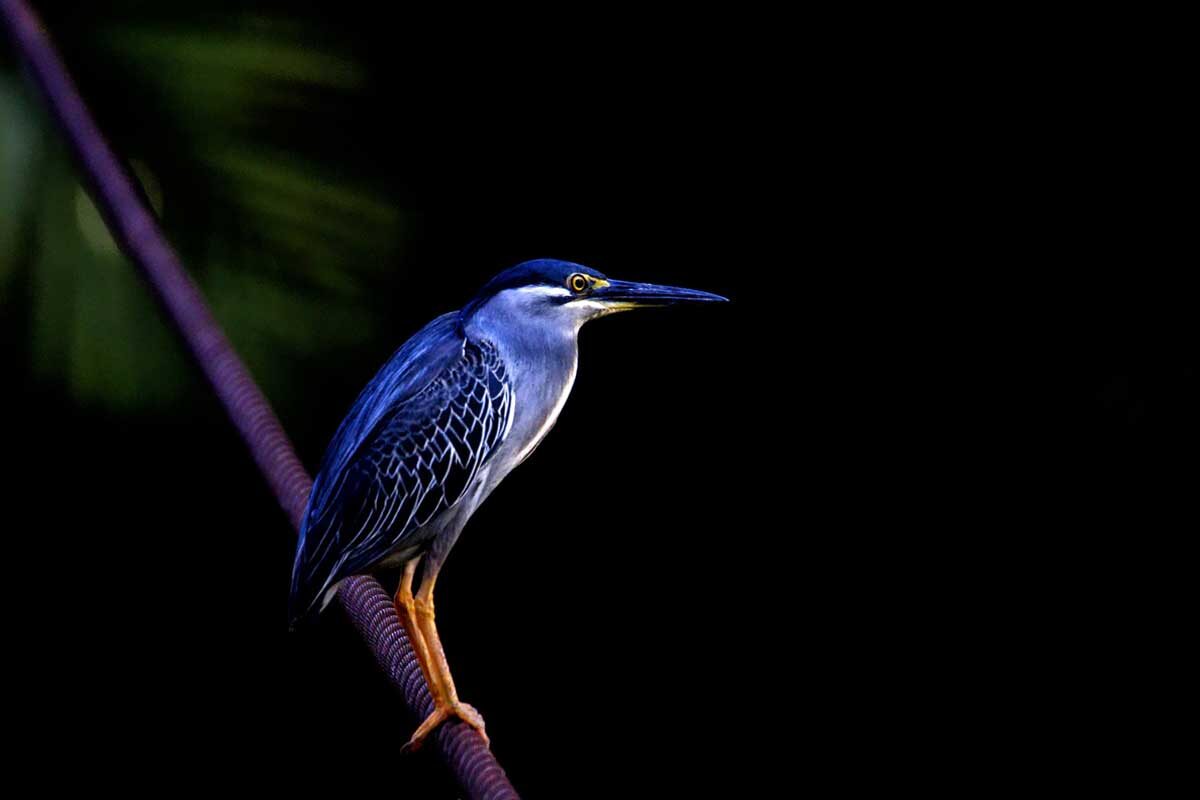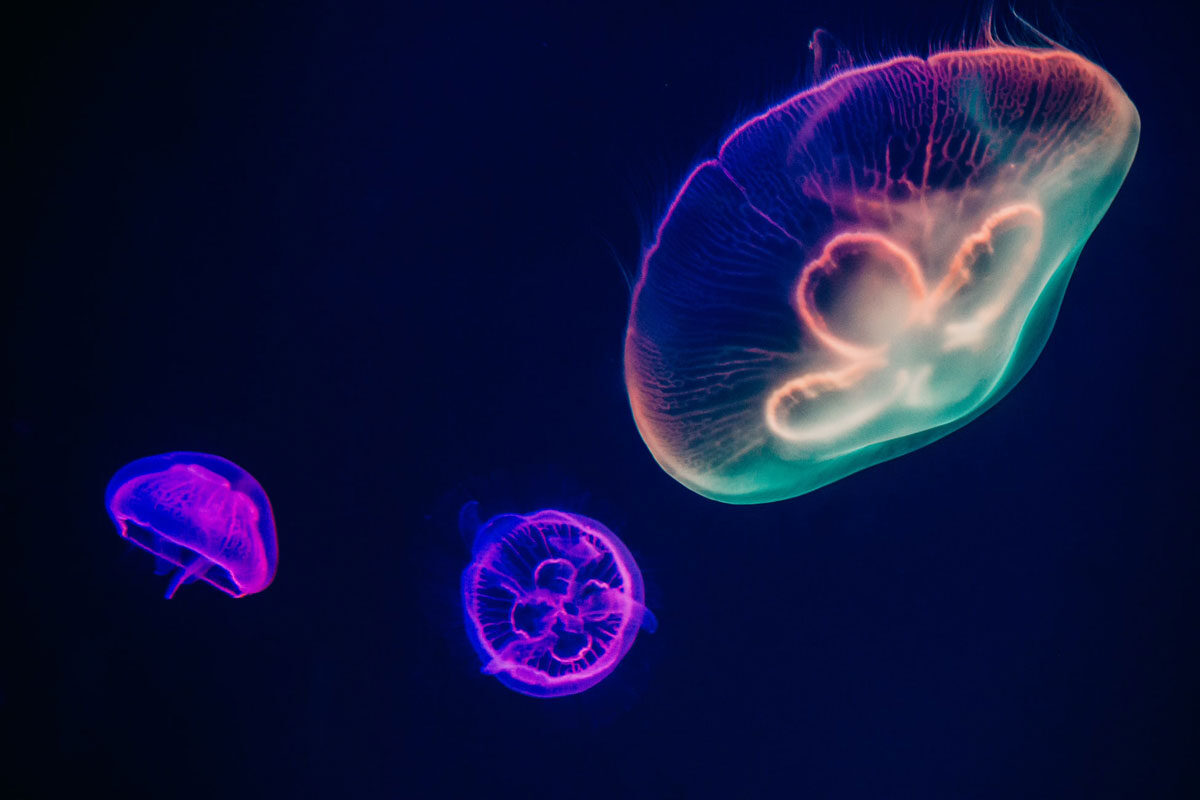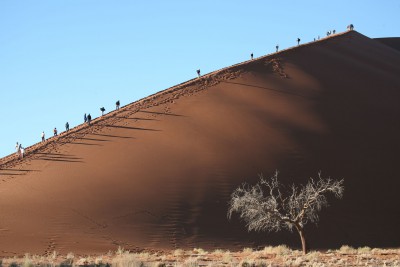Thought to be the oldest desert in the world at over 55 million years and the only true desert in Africa lying south of the equator, the Namib runs from southern Angola to Lüderitz in the far south of Namibia. With an area of 80,950 km², the Namib Desert extends 1570km along the Atlantic coastline and 50-160 km towards the interior. Its aridity is caused by the combination of coastal air being cooled by the cold waters of the Benguela current (descending and becoming less able to bear water) with hot dry winds from the east that have lost their moisture over the mountains. The hot and cold air currents meet at the coastline, often forming fog – a life-giving source of moisture for specialist desert-dwelling plants and animals, and a major hazard for sailors whose shipwrecks line the Skeleton Coast.
The flora and flora of the Namib Desert is weird and wonderful, including the ‘living fossil’ plant Welwitschia mirabilis, a relict gymnosperm which grows close to the ground and has its own taxonomic group. Very slow-growing and officially a tree, Welwitschias can live over 1000 years (the largest are estimated at around 2,500 years old), collecting moisture from the coastal fog through specially adapted leaves.
Wildlife biodiversity is high in reptiles with around 70 species with 25 endemic or near-endemic to the Namib Desert. The wedge-snouted sand lizard, small-scaled sand lizard, web-footed gecko, barking gecko and Namib day gecko all dive beneath the sand when they sense danger. Small rodents include Grant’s golden mole which can ‘swim’ through the sand dunes, gerbils, the Namaqua dune mole rat, the Namib long-eared bat and Angola wing-gland bat which feed on the dune dwelling insects. This is also the home to Peringuey’s adder (Namib Desert sidewinder) – an ambush hunter that buries itself beneath the sand, with only the eyes and tip of its tail exposed, waiting for prey such as desert lizards. When on the move it has a wonderful side-winding motion to give it purchase on the shifting sand. The Namaqua chameleon is also specially adapted to the desert, digging holes and changing colour throughout the day to help thermoregulation and excreting salt from nasal glands to conserve water. They stalk prey such as beetles, crickets, scorpions and lizards, and are in turn hunted by hawks, eagles and jackals.
Desert insects includes tiny endemic Namib Desert darkling beetles or “fog beetles” which use their bodies as fog collectors by assuming the characteristic fog-basking pose, while the ‘flying saucer trench beetle’ digs trenches to capture the fog’s moisture to drink.
Larger animals of the Namib include gemsbok (oryx) which can regulate their body temperature and survive for weeks without drinking, springbok, klipspringer, steenbok and Hartmann’s zebra towards the eastern boundary. Predators include spotted and brown hyena, cheetah, Cape fox and bat-eared fox. Other species such as baboon and leopard are mostly confined to the rivers.
Of the 180 bird species found in the Namib Desert, the most prominent bird found is the ostrich. There are six endemic birds: the dune lark, Benguela long-billed lark, Gray’s lark, bank cormorant, tractrac chat, and Rüppell’s korhaan. As the environment is so harsh, most birds of the Namib are concentrated along the coastline, with hotspots in Walvis Bay and Sandwich Harbour areas.
A strange phenomenon in the Namib Desert is the presence of ‘fairy circles’. Best seen from the air, these denuded circles of grassland of 5-8m average diameter dot the landscape for miles. Fairy circles (also known as ‘fairy rings’) can be found on the eastern border regions of the desert from southern Angola to the Orange River in the south. There are several theories about their cause: the residue of allopathic growth inhibitors by Euphorbia plants, radioactivity, Gods or, indeed, fairies. A more likely explanation seems to be harvester ants or harvester termites which gather vegetable matter from the affected area. However, despite various studies, concrete scientific evidence for any of the theories remains lacking and the mystery remains. Fairy circles last around 100 years before becoming re-colonised by plants.
Although mostly impenetrable and uninhabited, permanent settlements in the Namib Desert include Sesriem (near Sossusvlei), Lüderitz, Walvis Bay and Swakopmund. The Namib Desert is mineral-rich and an important area for salt, tungsten and diamond mining. Protected areas within the Namib Desert include the Namib-Naukluft Park, NamibRand Private Nature Reserve, Dorob National Park and the Skeleton Coast Park.













